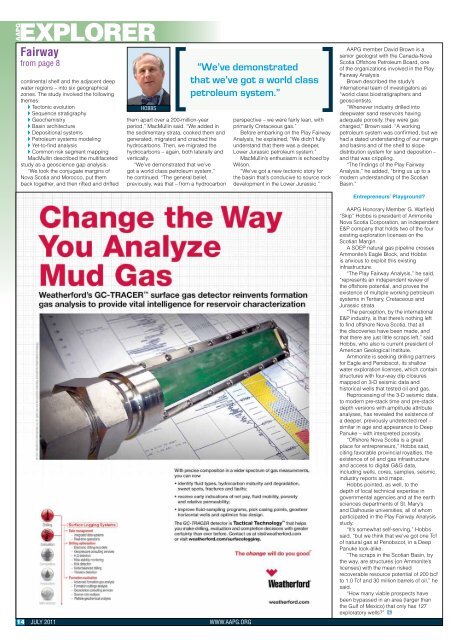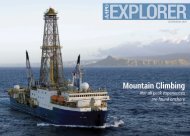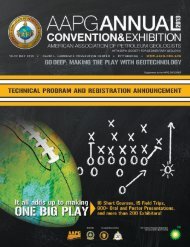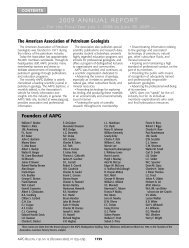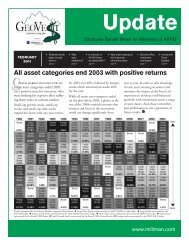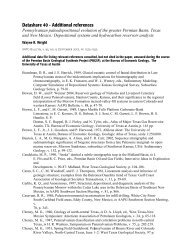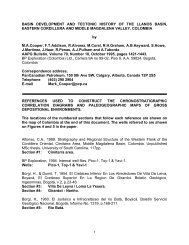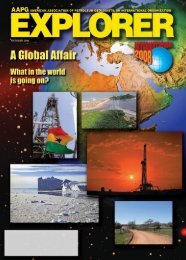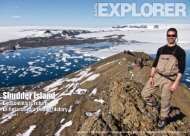AAPG Explorer - American Association of Petroleum Geologists
AAPG Explorer - American Association of Petroleum Geologists
AAPG Explorer - American Association of Petroleum Geologists
You also want an ePaper? Increase the reach of your titles
YUMPU automatically turns print PDFs into web optimized ePapers that Google loves.
<strong>AAPG</strong><br />
EXPLORER<br />
Fairway<br />
from page 8<br />
continental shelf and the adjacent deep<br />
water regions – into six geographical<br />
zones. The study involved the following<br />
themes:<br />
u Tectonic evolution<br />
u Sequence stratigraphy<br />
u Geochemistry<br />
u Basin architecture<br />
u Depositional systems<br />
u <strong>Petroleum</strong> systems modeling<br />
u Yet-to-find analysis<br />
u Common risk segment mapping<br />
MacMullin described the multifaceted<br />
study as a geoscience gap analysis:<br />
“We took the conjugate margins <strong>of</strong><br />
Nova Scotia and Morocco, put them<br />
back together, and then rifted and drifted<br />
HOBBS<br />
them apart over a 200-million-year<br />
period,” MacMullin said. “We added in<br />
the sedimentary strata, cooked them and<br />
generated, migrated and cracked the<br />
hydrocarbons. Then, we migrated the<br />
hydrocarbons – again, both laterally and<br />
vertically.<br />
“We’ve demonstrated that we’ve<br />
got a world class petroleum system,”<br />
he continued. “The general belief,<br />
previously, was that – from a hydrocarbon<br />
14 JULY 2011 WWW.<strong>AAPG</strong>.ORG<br />
“We’ve demonstrated<br />
that we’ve got a world class<br />
petroleum system.”<br />
perspective – we were fairly lean, with<br />
primarily Cretaceous gas.”<br />
Before embarking on the Play Fairway<br />
Analysis, he explained, “We didn’t fully<br />
understand that there was a deeper,<br />
Lower Jurassic petroleum system.”<br />
MacMullin’s enthusiasm is echoed by<br />
Wilson.<br />
“We’ve got a new tectonic story for<br />
the basin that’s conducive to source rock<br />
development in the Lower Jurassic.”<br />
<strong>AAPG</strong> member David Brown is a<br />
senior geologist with the Canada-Nova<br />
Scotia Offshore <strong>Petroleum</strong> Board, one<br />
<strong>of</strong> the organizations involved in the Play<br />
Fairway Analysis.<br />
Brown described the study’s<br />
international team <strong>of</strong> investigators as<br />
“world class biostratigraphers and<br />
geoscientists.<br />
“Whenever industry drilled into<br />
deepwater sand reservoirs having<br />
adequate porosity, they were gas<br />
charged,” Brown said. “A working<br />
petroleum system was confirmed, but we<br />
had a dated understanding <strong>of</strong> our margin<br />
and basins and <strong>of</strong> the shelf to slope<br />
distribution system for sand deposition –<br />
and that was crippling.<br />
“The findings <strong>of</strong> the Play Fairway<br />
Analysis,” he added, “bring us up to a<br />
modern understanding <strong>of</strong> the Scotian<br />
Basin.”<br />
Entrepreneurs’ Playground?<br />
<strong>AAPG</strong> Honorary Member G. Warfield<br />
“Skip” Hobbs is president <strong>of</strong> Ammonite<br />
Nova Scotia Corporation, an independent<br />
E&P company that holds two <strong>of</strong> the four<br />
existing exploration licenses on the<br />
Scotian Margin.<br />
A SOEP natural gas pipeline crosses<br />
Ammonite’s Eagle Block, and Hobbs<br />
is anxious to exploit this existing<br />
infrastructure.<br />
“The Play Fairway Analysis,” he said,<br />
“represents an independent review <strong>of</strong><br />
the <strong>of</strong>fshore potential, and proves the<br />
existence <strong>of</strong> multiple working petroleum<br />
systems in Tertiary, Cretaceous and<br />
Jurassic strata.<br />
“The perception, by the international<br />
E&P industry, is that there’s nothing left<br />
to find <strong>of</strong>fshore Nova Scotia, that all<br />
the discoveries have been made, and<br />
that there are just little scraps left,” said<br />
Hobbs, who also is current president <strong>of</strong><br />
<strong>American</strong> Geological Institute.<br />
Ammonite is seeking drilling partners<br />
for Eagle and Penobscot, its shallow<br />
water exploration licenses, which contain<br />
structures with four-way dip closures<br />
mapped on 3-D seismic data and<br />
historical wells that tested oil and gas.<br />
Reprocessing <strong>of</strong> the 3-D seismic data,<br />
to modern pre-stack time and pre-stack<br />
depth versions with amplitude attribute<br />
analyses, has revealed the existence <strong>of</strong><br />
a deeper, previously undetected reef –<br />
similar in age and appearance to Deep<br />
Panuke – with interpreted porosity.<br />
“Offshore Nova Scotia is a great<br />
place for entrepreneurs,” Hobbs said,<br />
citing favorable provincial royalties, the<br />
existence <strong>of</strong> oil and gas infrastructure<br />
and access to digital G&G data,<br />
including wells, cores, samples, seismic,<br />
industry reports and maps.<br />
Hobbs pointed, as well, to the<br />
depth <strong>of</strong> local technical expertise in<br />
governmental agencies and at the earth<br />
sciences departments <strong>of</strong> St. Mary’s<br />
and Dalhousie universities, all <strong>of</strong> whom<br />
participated in the Play Fairway Analysis<br />
study.<br />
“It’s somewhat self-serving,” Hobbs<br />
said, “but we think that we’ve got one Tcf<br />
<strong>of</strong> natural gas at Penobscot, in a Deep<br />
Panuke look-alike.<br />
“The scraps in the Scotian Basin, by<br />
the way, are structures (on Ammonite’s<br />
licenses) with the mean risked<br />
recoverable resource potential <strong>of</strong> 200 bcf<br />
to 1.0 Tcf and 30 million barrels <strong>of</strong> oil,” he<br />
said.<br />
“How many viable prospects have<br />
been bypassed in an area (larger than<br />
the Gulf <strong>of</strong> Mexico) that only has 127<br />
exploratory wells?” EXPLORER


